roof BMW 328I SEDAN 2012 User Guide
[x] Cancel search | Manufacturer: BMW, Model Year: 2012, Model line: 328I SEDAN, Model: BMW 328I SEDAN 2012Pages: 325, PDF Size: 12.26 MB
Page 156 of 325
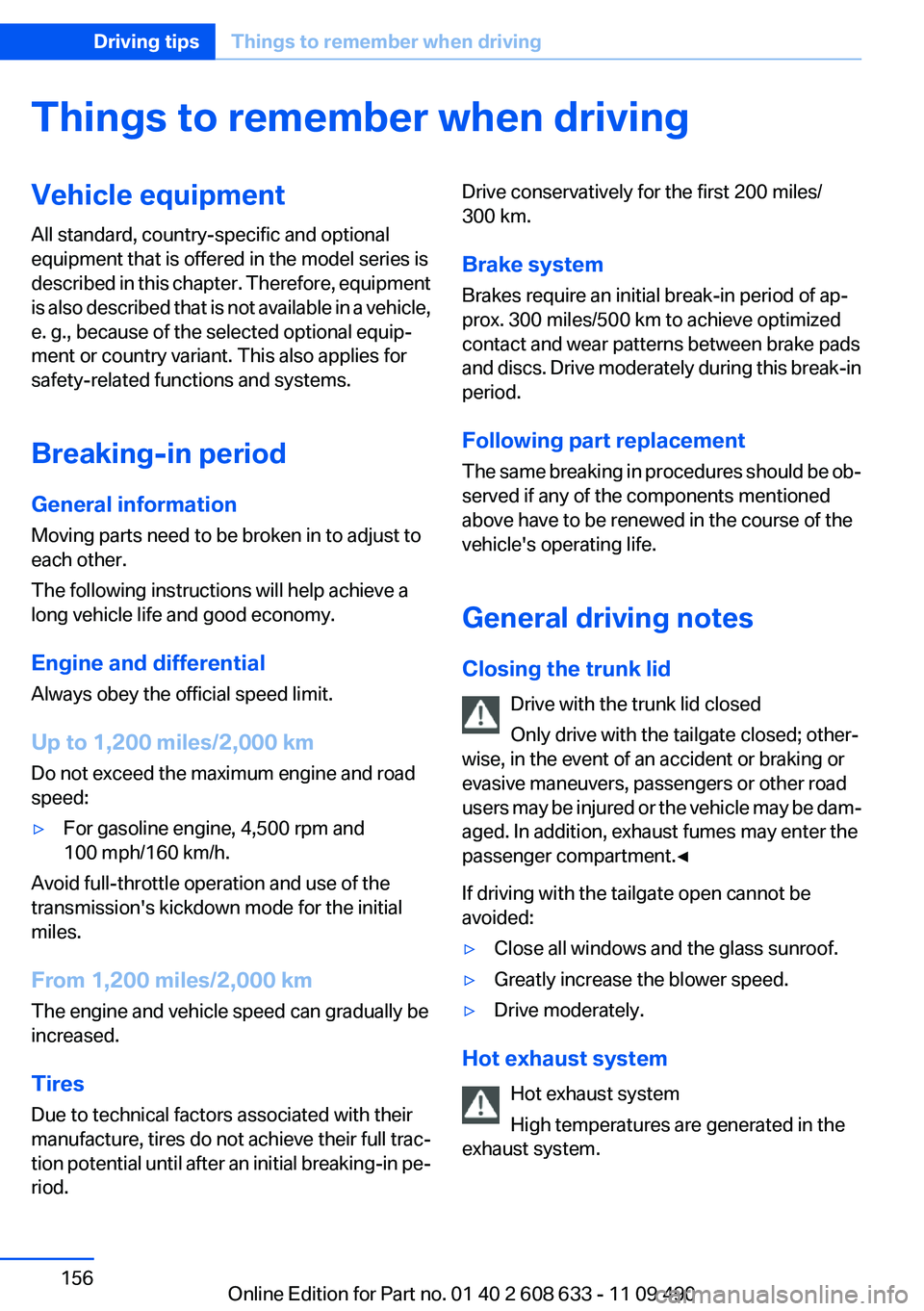
Things to remember when drivingVehicle equipment
All standard, country-specific and optional
equipment that is offered in the model series is
described in this chapter. Therefore, equipment
is also described that is not available in a vehicle,
e. g., because of the selected optional equipтАР
ment or country variant. This also applies for
safety-related functions and systems.
Breaking-in period
General information
Moving parts need to be broken in to adjust to
each other.
The following instructions will help achieve a
long vehicle life and good economy.
Engine and differential
Always obey the official speed limit.
Up to 1,200 miles/2,000 km
Do not exceed the maximum engine and road
speed:тЦ╖For gasoline engine, 4,500 rpm and
100 mph/160 km/h.
Avoid full-throttle operation and use of the
transmission's kickdown mode for the initial
miles.
From 1,200 miles/2,000 km
The engine and vehicle speed can gradually be
increased.
Tires
Due to technical factors associated with their
manufacture, tires do not achieve their full tracтАР
tion potential until after an initial breaking-in peтАР
riod.
Drive conservatively for the first 200 miles/
300 km.
Brake system
Brakes require an initial break-in period of apтАР
prox. 300 miles/500 km to achieve optimized
contact and wear patterns between brake pads
and discs. Drive moderately during this break-in
period.
Following part replacement
The same breaking in procedures should be obтАР
served if any of the components mentioned
above have to be renewed in the course of the
vehicle's operating life.
General driving notes
Closing the trunk lid Drive with the trunk lid closed
Only drive with the tailgate closed; otherтАР
wise, in the event of an accident or braking or
evasive maneuvers, passengers or other road
users may be injured or the vehicle may be damтАР
aged. In addition, exhaust fumes may enter the
passenger compartment.тЧА
If driving with the tailgate open cannot be
avoided:тЦ╖Close all windows and the glass sunroof.тЦ╖Greatly increase the blower speed.тЦ╖Drive moderately.
Hot exhaust system
Hot exhaust system
High temperatures are generated in the
exhaust system.
Seite 156Driving tipsThings to remember when driving156
Online Edition for Part no. 01 40 2 608 633 - 11 09 490
Page 160 of 325
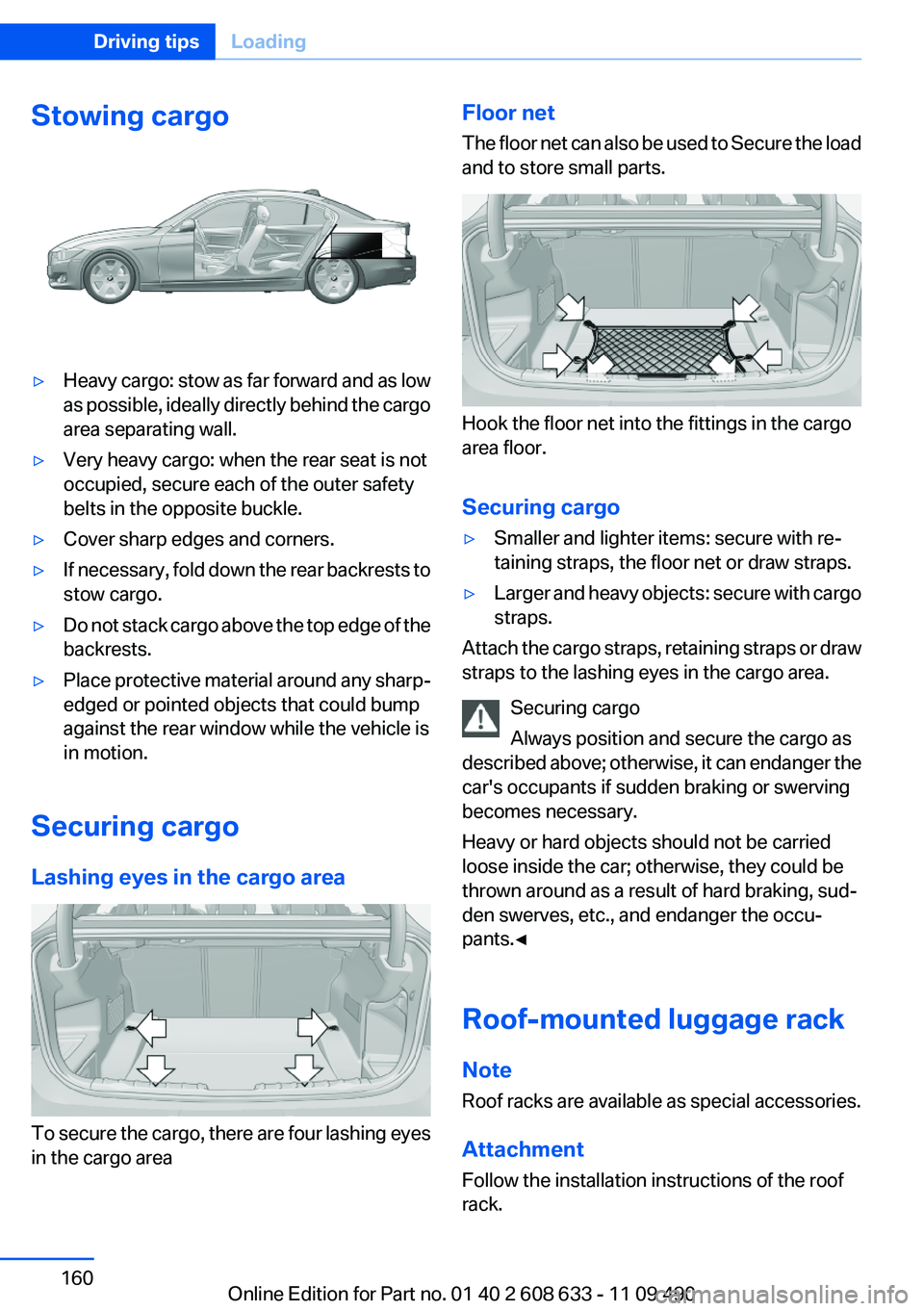
Stowing cargoтЦ╖Heavy cargo: stow as far forward and as low
as possible, ideally directly behind the cargo
area separating wall.тЦ╖Very heavy cargo: when the rear seat is not
occupied, secure each of the outer safety
belts in the opposite buckle.тЦ╖Cover sharp edges and corners.тЦ╖If necessary, fold down the rear backrests to
stow cargo.тЦ╖Do not stack cargo above the top edge of the
backrests.тЦ╖Place protective material around any sharp-
edged or pointed objects that could bump
against the rear window while the vehicle is
in motion.
Securing cargo
Lashing eyes in the cargo area
To secure the cargo, there are four lashing eyes
in the cargo area
Floor net
The floor net can also be used to Secure the load
and to store small parts.
Hook the floor net into the fittings in the cargo
area floor.
Securing cargo
тЦ╖Smaller and lighter items: secure with reтАР
taining straps, the floor net or draw straps.тЦ╖Larger and heavy objects: secure with cargo
straps.
Attach the cargo straps, retaining straps or draw
straps to the lashing eyes in the cargo area.
Securing cargo
Always position and secure the cargo as
described above; otherwise, it can endanger the
car's occupants if sudden braking or swerving
becomes necessary.
Heavy or hard objects should not be carried
loose inside the car; otherwise, they could be
thrown around as a result of hard braking, sudтАР
den swerves, etc., and endanger the occuтАР
pants.тЧА
Roof-mounted luggage rack
Note
Roof racks are available as special accessories.
Attachment
Follow the installation instructions of the roof
rack.
Seite 160Driving tipsLoading160
Online Edition for Part no. 01 40 2 608 633 - 11 09 490
Page 161 of 325
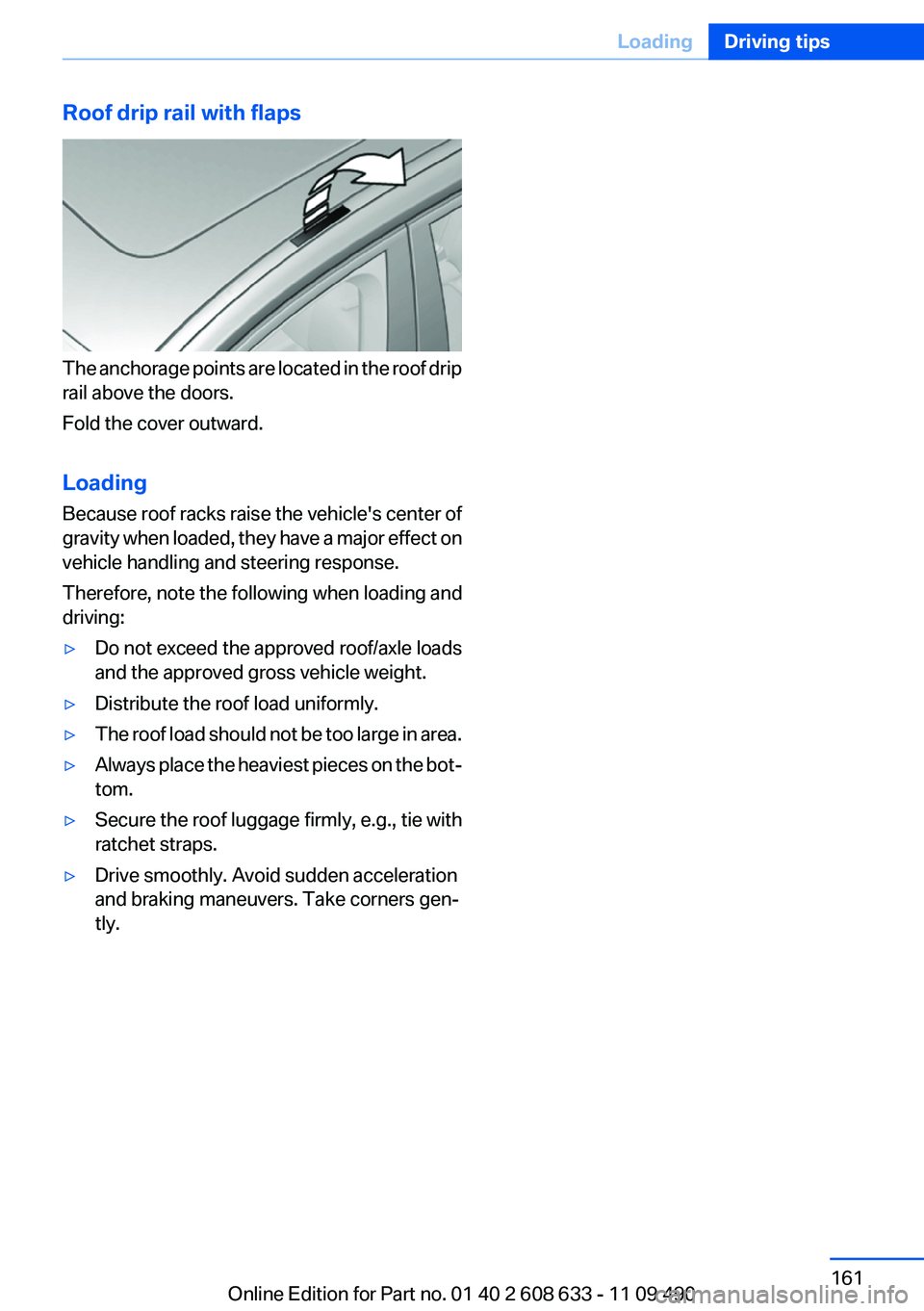
Roof drip rail with flaps
The anchorage points are located in the roof drip
rail above the doors.
Fold the cover outward.
Loading
Because roof racks raise the vehicle's center of
gravity when loaded, they have a major effect on
vehicle handling and steering response.
Therefore, note the following when loading and
driving:
тЦ╖Do not exceed the approved roof/axle loads
and the approved gross vehicle weight.тЦ╖Distribute the roof load uniformly.тЦ╖The roof load should not be too large in area.тЦ╖Always place the heaviest pieces on the botтАР
tom.тЦ╖Secure the roof luggage firmly, e.g., tie with
ratchet straps.тЦ╖Drive smoothly. Avoid sudden acceleration
and braking maneuvers. Take corners genтАР
tly.Seite 161LoadingDriving tips161
Online Edition for Part no. 01 40 2 608 633 - 11 09 490
Page 162 of 325
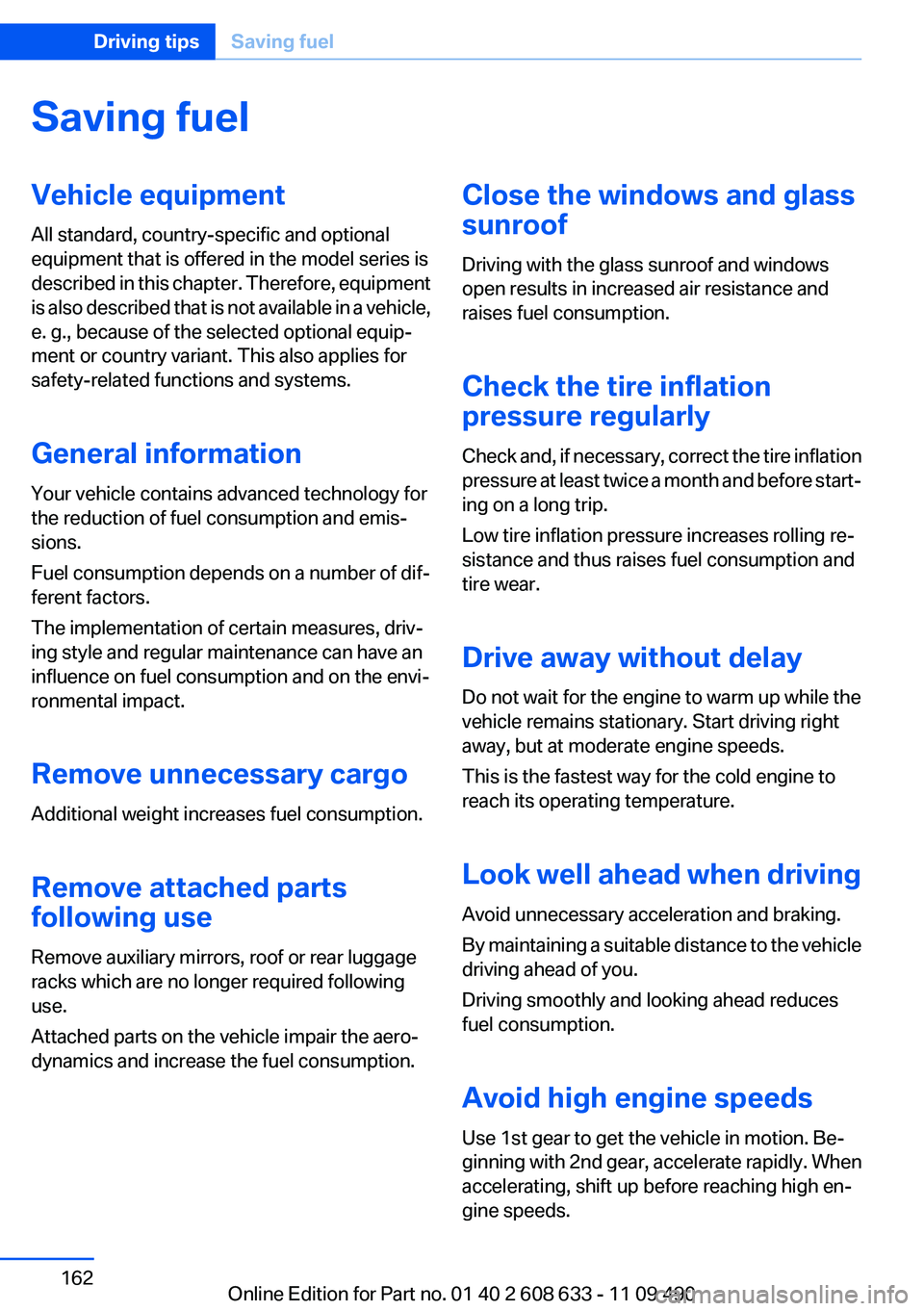
Saving fuelVehicle equipment
All standard, country-specific and optional
equipment that is offered in the model series is
described in this chapter. Therefore, equipment
is also described that is not available in a vehicle,
e. g., because of the selected optional equipтАР
ment or country variant. This also applies for
safety-related functions and systems.
General information
Your vehicle contains advanced technology for
the reduction of fuel consumption and emisтАР
sions.
Fuel consumption depends on a number of difтАР
ferent factors.
The implementation of certain measures, drivтАР
ing style and regular maintenance can have an
influence on fuel consumption and on the enviтАР
ronmental impact.
Remove unnecessary cargo
Additional weight increases fuel consumption.
Remove attached parts
following use
Remove auxiliary mirrors, roof or rear luggage
racks which are no longer required following
use.
Attached parts on the vehicle impair the aeroтАР
dynamics and increase the fuel consumption.Close the windows and glass
sunroof
Driving with the glass sunroof and windows
open results in increased air resistance and
raises fuel consumption.
Check the tire inflation
pressure regularly
Check and, if necessary, correct the tire inflation
pressure at least twice a month and before startтАР
ing on a long trip.
Low tire inflation pressure increases rolling reтАР
sistance and thus raises fuel consumption and
tire wear.
Drive away without delay
Do not wait for the engine to warm up while the
vehicle remains stationary. Start driving right
away, but at moderate engine speeds.
This is the fastest way for the cold engine to
reach its operating temperature.
Look well ahead when driving
Avoid unnecessary acceleration and braking.
By maintaining a suitable distance to the vehicle
driving ahead of you.
Driving smoothly and looking ahead reduces
fuel consumption.
Avoid high engine speeds
Use 1st gear to get the vehicle in motion. BeтАР
ginning with 2nd gear, accelerate rapidly. When
accelerating, shift up before reaching high enтАР
gine speeds.Seite 162Driving tipsSaving fuel162
Online Edition for Part no. 01 40 2 608 633 - 11 09 490
Page 277 of 325
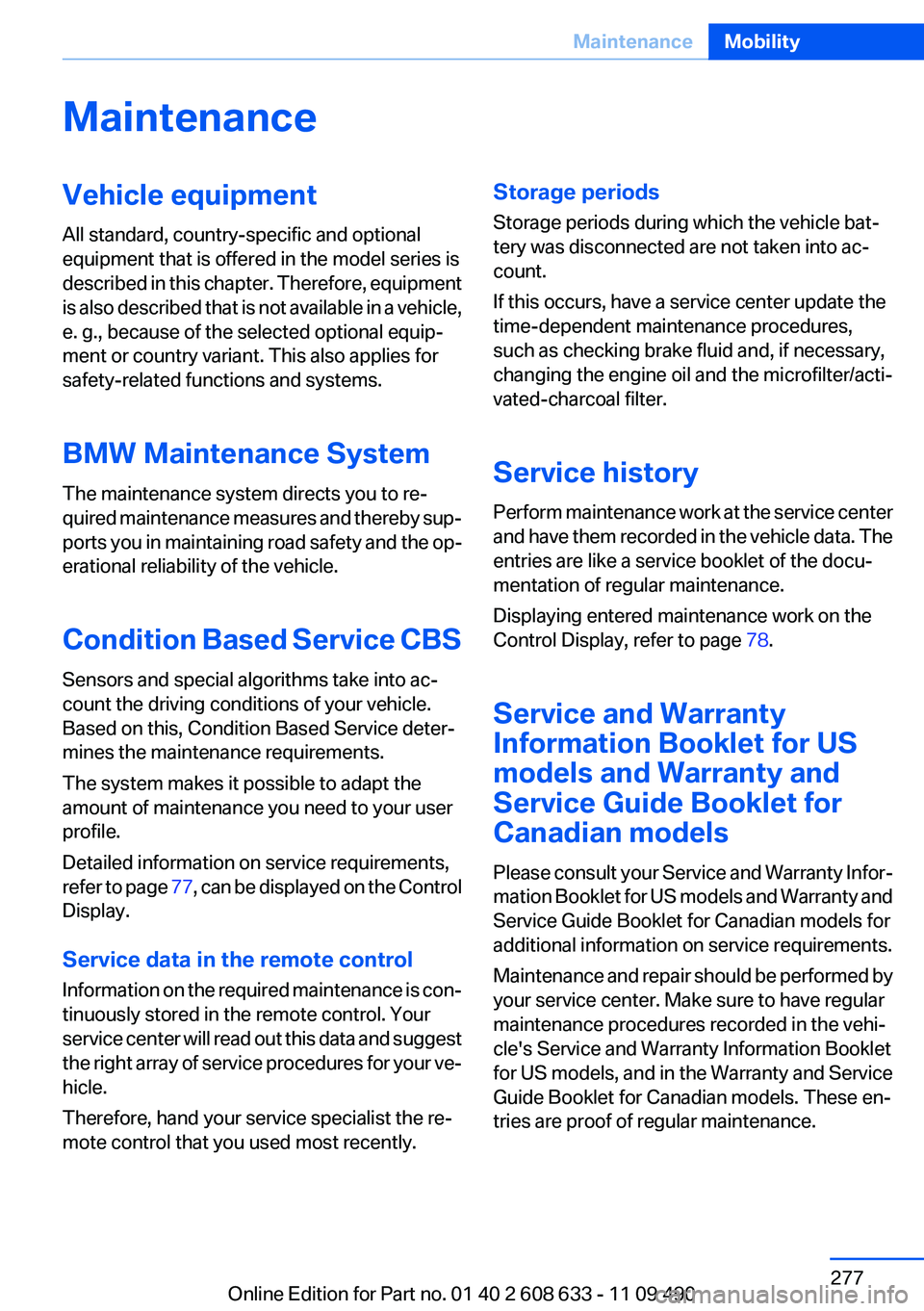
MaintenanceVehicle equipment
All standard, country-specific and optional
equipment that is offered in the model series is
described in this chapter. Therefore, equipment
is also described that is not available in a vehicle,
e. g., because of the selected optional equipтАР
ment or country variant. This also applies for
safety-related functions and systems.
BMW Maintenance System
The maintenance system directs you to reтАР
quired maintenance measures and thereby supтАР
ports you in maintaining road safety and the opтАР
erational reliability of the vehicle.
Condition Based Service CBS
Sensors and special algorithms take into acтАР
count the driving conditions of your vehicle.
Based on this, Condition Based Service deterтАР
mines the maintenance requirements.
The system makes it possible to adapt the
amount of maintenance you need to your user
profile.
Detailed information on service requirements,
refer to page 77, can be displayed on the Control
Display.
Service data in the remote control
Information on the required maintenance is conтАР
tinuously stored in the remote control. Your
service center will read out this data and suggest
the right array of service procedures for your veтАР
hicle.
Therefore, hand your service specialist the reтАР
mote control that you used most recently.Storage periods
Storage periods during which the vehicle batтАР
tery was disconnected are not taken into acтАР
count.
If this occurs, have a service center update the
time-dependent maintenance procedures,
such as checking brake fluid and, if necessary,
changing the engine oil and the microfilter/actiтАР
vated-charcoal filter.
Service history
Perform maintenance work at the service center
and have them recorded in the vehicle data. The
entries are like a service booklet of the docuтАР
mentation of regular maintenance.
Displaying entered maintenance work on the
Control Display, refer to page 78.
Service and Warranty
Information Booklet for US
models and Warranty and
Service Guide Booklet for
Canadian models
Please consult your Service and Warranty InforтАР
mation Booklet for US models and Warranty and
Service Guide Booklet for Canadian models for
additional information on service requirements.
Maintenance and repair should be performed by
your service center. Make sure to have regular
maintenance procedures recorded in the vehiтАР
cle's Service and Warranty Information Booklet
for US models, and in the Warranty and Service
Guide Booklet for Canadian models. These enтАР
tries are proof of regular maintenance.Seite 277MaintenanceMobility277
Online Edition for Part no. 01 40 2 608 633 - 11 09 490
Page 302 of 325
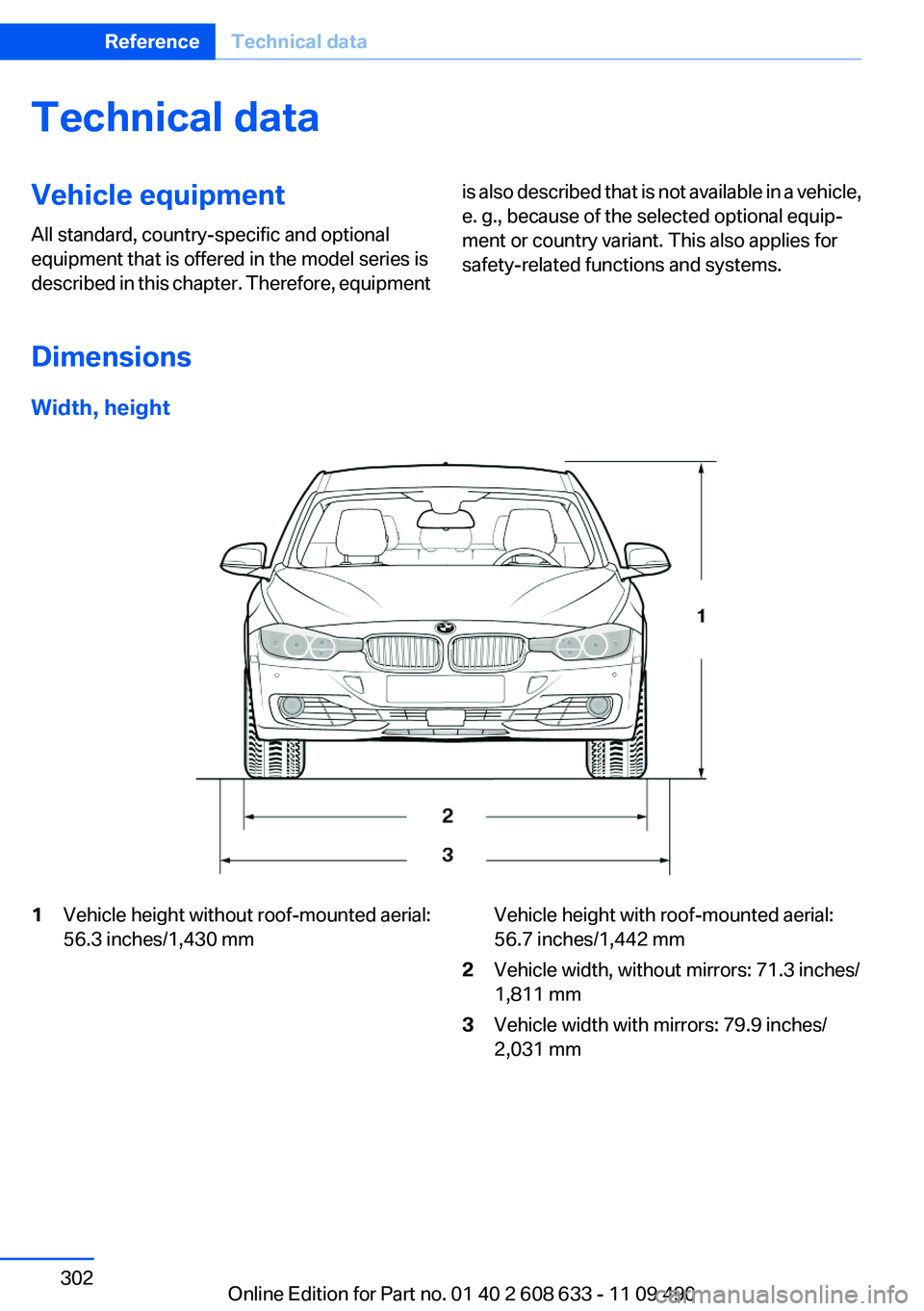
Technical dataVehicle equipment
All standard, country-specific and optional
equipment that is offered in the model series is
described in this chapter. Therefore, equipmentis also described that is not available in a vehicle,
e. g., because of the selected optional equipтАР
ment or country variant. This also applies for
safety-related functions and systems.
Dimensions
Width, height
1Vehicle height without roof-mounted aerial:
56.3 inches/1,430 mmVehicle height with roof-mounted aerial:
56.7 inches/1,442 mm2Vehicle width, without mirrors: 71.3 inches/
1,811 mm3Vehicle width with mirrors: 79.9 inches/
2,031 mmSeite 302ReferenceTechnical data302
Online Edition for Part no. 01 40 2 608 633 - 11 09 490
Page 304 of 325
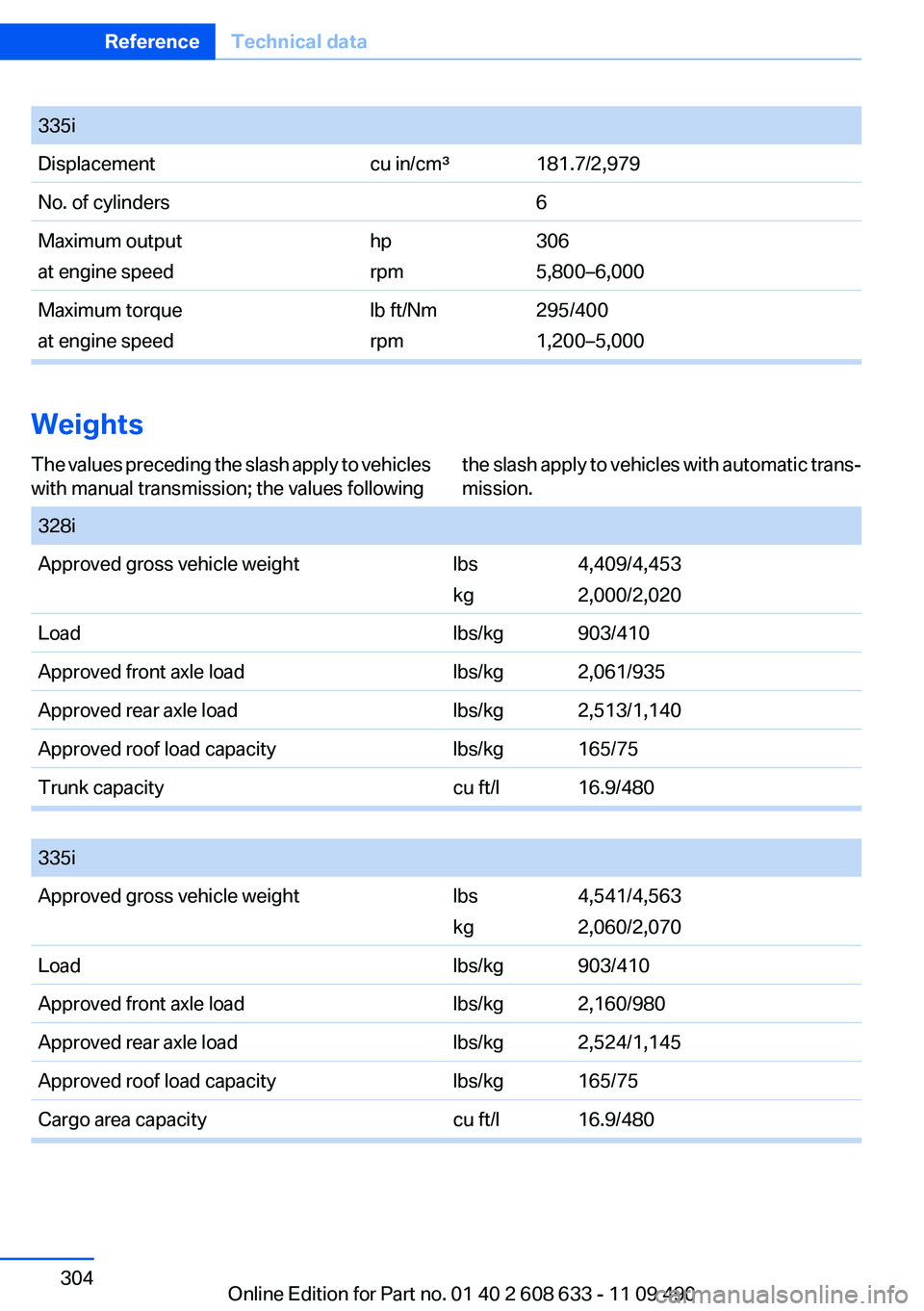
335iDisplacementcu in/cm┬│181.7/2,979No. of cylinders6Maximum output
at engine speedhp
rpm306
5,800тАУ6,000Maximum torque
at engine speedlb ft/Nm
rpm295/400
1,200тАУ5,000
Weights
The values preceding the slash apply to vehicles
with manual transmission; the values followingthe slash apply to vehicles with automatic transтАР
mission. 328iApproved gross vehicle weightlbs
kg4,409/4,453
2,000/2,020Loadlbs/kg903/410Approved front axle loadlbs/kg2,061/935Approved rear axle loadlbs/kg2,513/1,140Approved roof load capacitylbs/kg165/75Trunk capacitycu ft/l16.9/480
335iApproved gross vehicle weightlbs
kg4,541/4,563
2,060/2,070Loadlbs/kg903/410Approved front axle loadlbs/kg2,160/980Approved rear axle loadlbs/kg2,524/1,145Approved roof load capacitylbs/kg165/75Cargo area capacitycu ft/l16.9/480Seite 304ReferenceTechnical data304
Online Edition for Part no. 01 40 2 608 633 - 11 09 490
Page 317 of 325
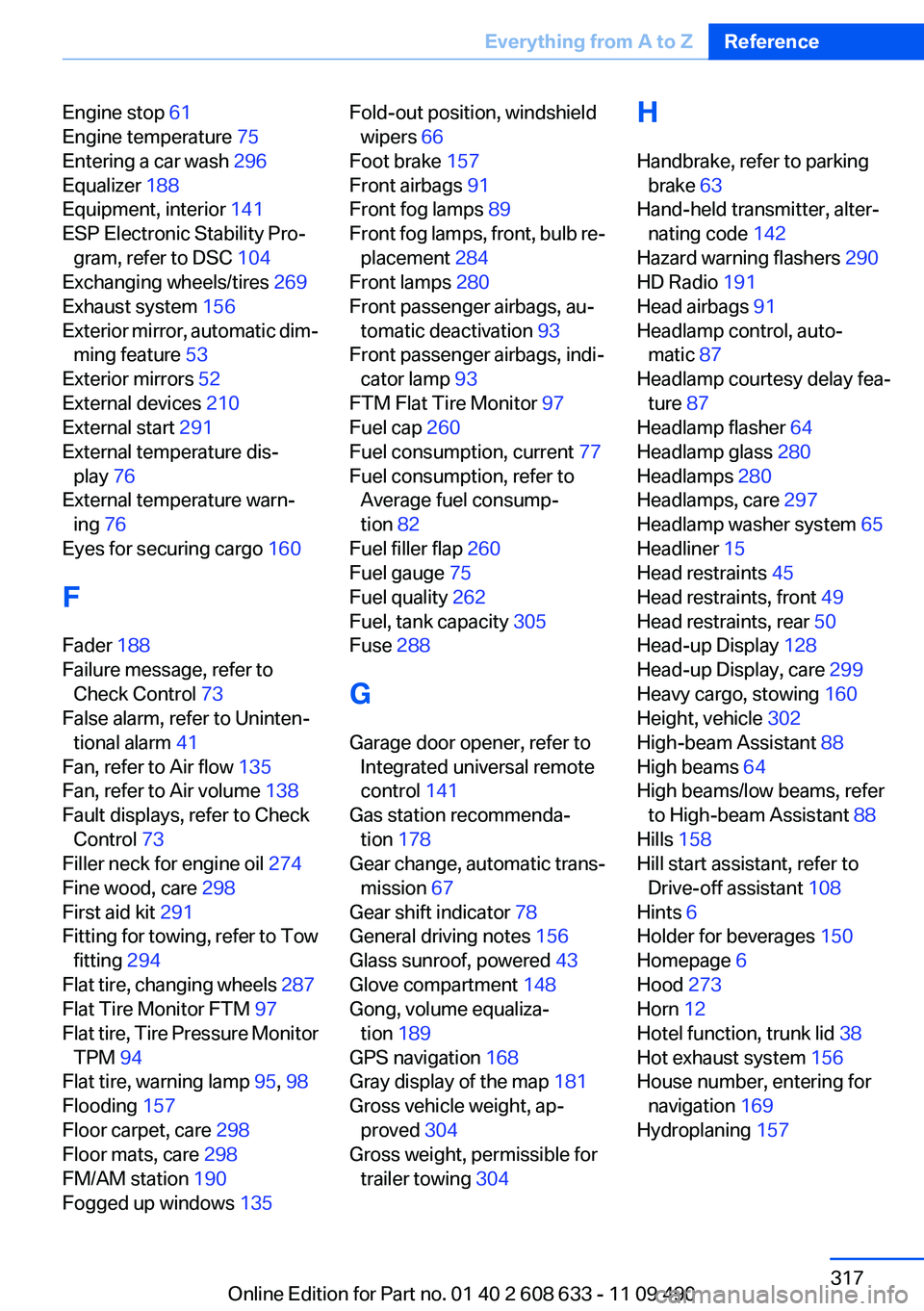
Engine stop 61
Engine temperature 75
Entering a car wash 296
Equalizer 188
Equipment, interior 141
ESP Electronic Stability ProтАР gram, refer to DSC 104
Exchanging wheels/tires 269
Exhaust system 156
Exterior mirror, automatic dimтАР ming feature 53
Exterior mirrors 52
External devices 210
External start 291
External temperature disтАР play 76
External temperature warnтАР ing 76
Eyes for securing cargo 160
F
Fader 188
Failure message, refer to Check Control 73
False alarm, refer to UnintenтАР tional alarm 41
Fan, refer to Air flow 135
Fan, refer to Air volume 138
Fault displays, refer to Check Control 73
Filler neck for engine oil 274
Fine wood, care 298
First aid kit 291
Fitting for towing, refer to Tow fitting 294
Flat tire, changing wheels 287
Flat Tire Monitor FTM 97
Flat tire, Tire Pressure Monitor TPM 94
Flat tire, warning lamp 95, 98
Flooding 157
Floor carpet, care 298
Floor mats, care 298
FM/AM station 190
Fogged up windows 135 Fold-out position, windshield
wipers 66
Foot brake 157
Front airbags 91
Front fog lamps 89
Front fog lamps, front, bulb reтАР placement 284
Front lamps 280
Front passenger airbags, auтАР tomatic deactivation 93
Front passenger airbags, indiтАР cator lamp 93
FTM Flat Tire Monitor 97
Fuel cap 260
Fuel consumption, current 77
Fuel consumption, refer to Average fuel consumpтАР
tion 82
Fuel filler flap 260
Fuel gauge 75
Fuel quality 262
Fuel, tank capacity 305
Fuse 288
G
Garage door opener, refer to Integrated universal remote
control 141
Gas station recommendaтАР tion 178
Gear change, automatic transтАР mission 67
Gear shift indicator 78
General driving notes 156
Glass sunroof, powered 43
Glove compartment 148
Gong, volume equalizaтАР tion 189
GPS navigation 168
Gray display of the map 181
Gross vehicle weight, apтАР proved 304
Gross weight, permissible for trailer towing 304 H
Handbrake, refer to parking brake 63
Hand-held transmitter, alterтАР nating code 142
Hazard warning flashers 290
HD Radio 191
Head airbags 91
Headlamp control, autoтАР matic 87
Headlamp courtesy delay feaтАР ture 87
Headlamp flasher 64
Headlamp glass 280
Headlamps 280
Headlamps, care 297
Headlamp washer system 65
Headliner 15
Head restraints 45
Head restraints, front 49
Head restraints, rear 50
Head-up Display 128
Head-up Display, care 299
Heavy cargo, stowing 160
Height, vehicle 302
High-beam Assistant 88
High beams 64
High beams/low beams, refer to High-beam Assistant 88
Hills 158
Hill start assistant, refer to Drive-off assistant 108
Hints 6
Holder for beverages 150
Homepage 6
Hood 273
Horn 12
Hotel function, trunk lid 38
Hot exhaust system 156
House number, entering for navigation 169
Hydroplaning 157 Seite 317Everything from A to ZReference317
Online Edition for Part no. 01 40 2 608 633 - 11 09 490
Page 318 of 325
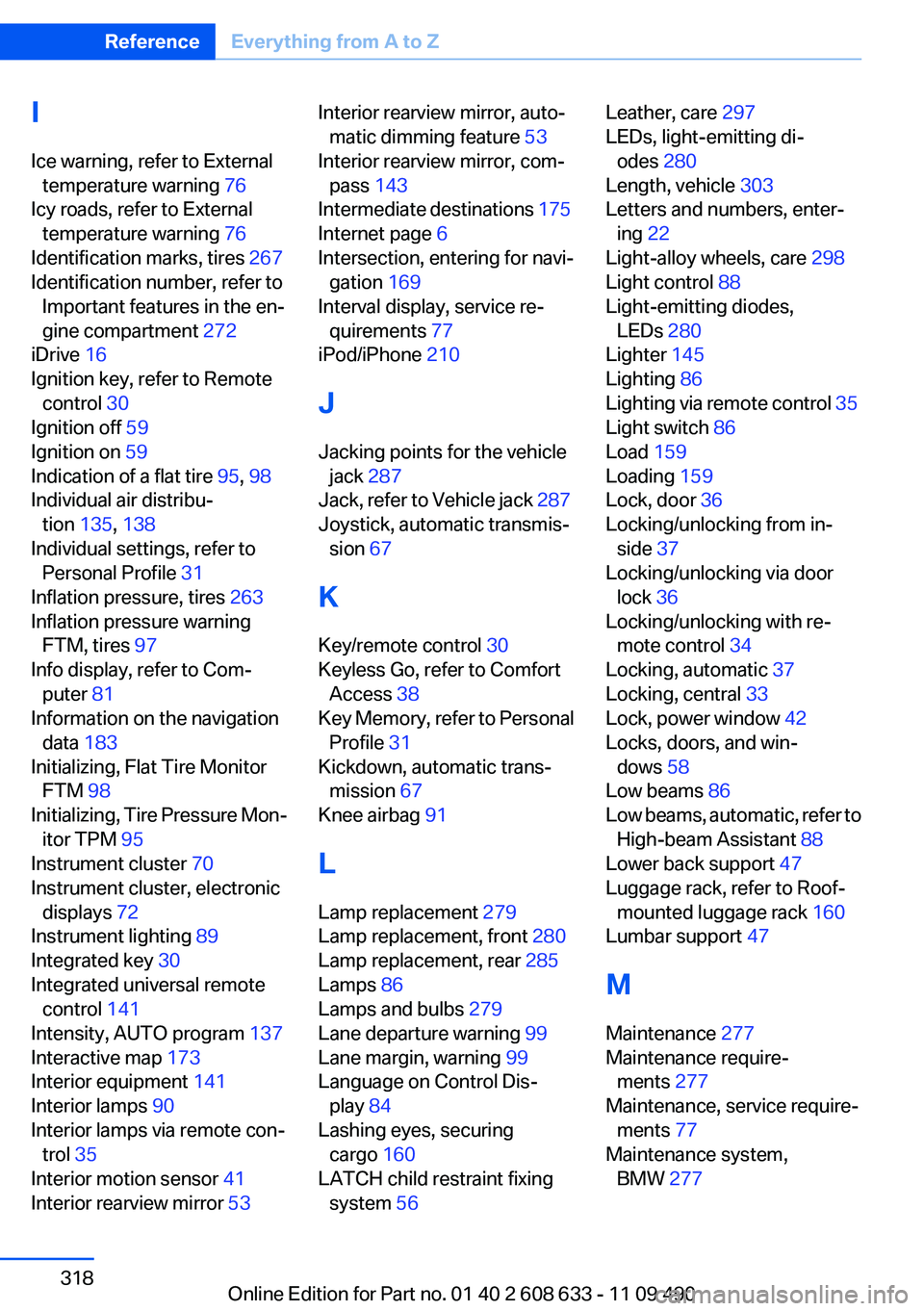
I
Ice warning, refer to External temperature warning 76
Icy roads, refer to External temperature warning 76
Identification marks, tires 267
Identification number, refer to Important features in the enтАР
gine compartment 272
iDrive 16
Ignition key, refer to Remote control 30
Ignition off 59
Ignition on 59
Indication of a flat tire 95, 98
Individual air distribuтАР tion 135, 138
Individual settings, refer to Personal Profile 31
Inflation pressure, tires 263
Inflation pressure warning FTM, tires 97
Info display, refer to ComтАР puter 81
Information on the navigation data 183
Initializing, Flat Tire Monitor FTM 98
Initializing, Tire Pressure MonтАР itor TPM 95
Instrument cluster 70
Instrument cluster, electronic displays 72
Instrument lighting 89
Integrated key 30
Integrated universal remote control 141
Intensity, AUTO program 137
Interactive map 173
Interior equipment 141
Interior lamps 90
Interior lamps via remote conтАР trol 35
Interior motion sensor 41
Interior rearview mirror 53 Interior rearview mirror, autoтАР
matic dimming feature 53
Interior rearview mirror, comтАР pass 143
Intermediate destinations 175
Internet page 6
Intersection, entering for naviтАР gation 169
Interval display, service reтАР quirements 77
iPod/iPhone 210
J
Jacking points for the vehicle jack 287
Jack, refer to Vehicle jack 287
Joystick, automatic transmisтАР sion 67
K
Key/remote control 30
Keyless Go, refer to Comfort Access 38
Key Memory, refer to Personal Profile 31
Kickdown, automatic transтАР mission 67
Knee airbag 91
L
Lamp replacement 279
Lamp replacement, front 280
Lamp replacement, rear 285
Lamps 86
Lamps and bulbs 279
Lane departure warning 99
Lane margin, warning 99
Language on Control DisтАР play 84
Lashing eyes, securing cargo 160
LATCH child restraint fixing system 56 Leather, care 297
LEDs, light-emitting diтАР odes 280
Length, vehicle 303
Letters and numbers, enterтАР ing 22
Light-alloy wheels, care 298
Light control 88
Light-emitting diodes, LEDs 280
Lighter 145
Lighting 86
Lighting via remote control 35
Light switch 86
Load 159
Loading 159
Lock, door 36
Locking/unlocking from inтАР side 37
Locking/unlocking via door lock 36
Locking/unlocking with reтАР mote control 34
Locking, automatic 37
Locking, central 33
Lock, power window 42
Locks, doors, and winтАР dows 58
Low beams 86
Low beams, automatic, refer to High-beam Assistant 88
Lower back support 47
Luggage rack, refer to Roof- mounted luggage rack 160
Lumbar support 47
M
Maintenance 277
Maintenance requireтАР ments 277
Maintenance, service requireтАР ments 77
Maintenance system, BMW 277 Seite 318ReferenceEverything from A to Z318
Online Edition for Part no. 01 40 2 608 633 - 11 09 490
Page 320 of 325
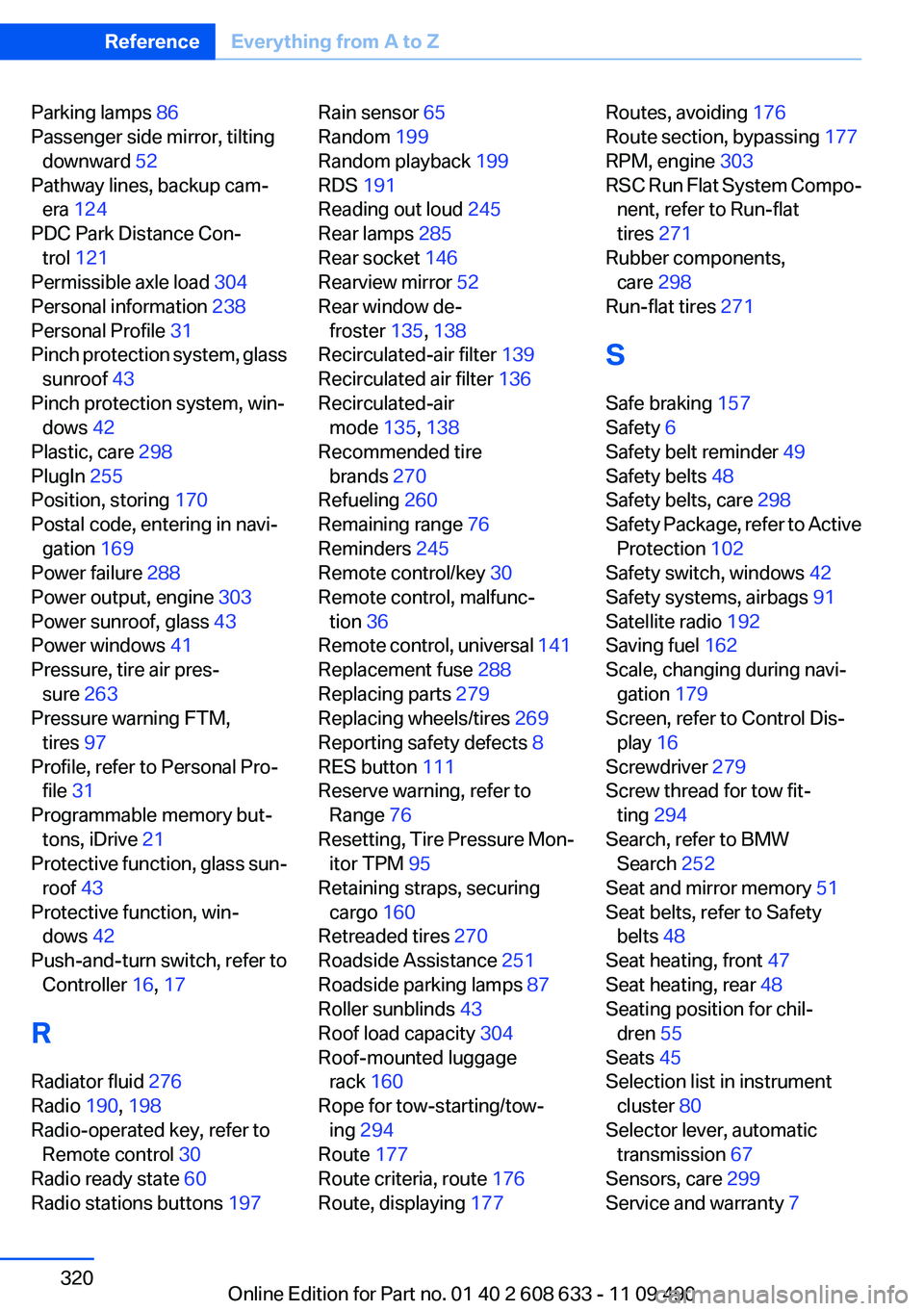
Parking lamps 86
Passenger side mirror, tilting downward 52
Pathway lines, backup camтАР era 124
PDC Park Distance ConтАР trol 121
Permissible axle load 304
Personal information 238
Personal Profile 31
Pinch protection system, glass sunroof 43
Pinch protection system, winтАР dows 42
Plastic, care 298
PlugIn 255
Position, storing 170
Postal code, entering in naviтАР gation 169
Power failure 288
Power output, engine 303
Power sunroof, glass 43
Power windows 41
Pressure, tire air presтАР sure 263
Pressure warning FTM, tires 97
Profile, refer to Personal ProтАР file 31
Programmable memory butтАР tons, iDrive 21
Protective function, glass sunтАР roof 43
Protective function, winтАР dows 42
Push-and-turn switch, refer to Controller 16, 17
R
Radiator fluid 276
Radio 190, 198
Radio-operated key, refer to Remote control 30
Radio ready state 60
Radio stations buttons 197 Rain sensor 65
Random 199
Random playback 199
RDS 191
Reading out loud 245
Rear lamps 285
Rear socket 146
Rearview mirror 52
Rear window deтАР froster 135, 138
Recirculated-air filter 139
Recirculated air filter 136
Recirculated-air mode 135, 138
Recommended tire brands 270
Refueling 260
Remaining range 76
Reminders 245
Remote control/key 30
Remote control, malfuncтАР tion 36
Remote control, universal 141
Replacement fuse 288
Replacing parts 279
Replacing wheels/tires 269
Reporting safety defects 8
RES button 111
Reserve warning, refer to Range 76
Resetting, Tire Pressure MonтАР itor TPM 95
Retaining straps, securing cargo 160
Retreaded tires 270
Roadside Assistance 251
Roadside parking lamps 87
Roller sunblinds 43
Roof load capacity 304
Roof-mounted luggage rack 160
Rope for tow-starting/towтАР ing 294
Route 177
Route criteria, route 176
Route, displaying 177 Routes, avoiding 176
Route section, bypassing 177
RPM, engine 303
RSC Run Flat System CompoтАР nent, refer to Run-flat
tires 271
Rubber components, care 298
Run-flat tires 271
S
Safe braking 157
Safety 6
Safety belt reminder 49
Safety belts 48
Safety belts, care 298
Safety Package, refer to Active Protection 102
Safety switch, windows 42
Safety systems, airbags 91
Satellite radio 192
Saving fuel 162
Scale, changing during naviтАР gation 179
Screen, refer to Control DisтАР play 16
Screwdriver 279
Screw thread for tow fitтАР ting 294
Search, refer to BMW Search 252
Seat and mirror memory 51
Seat belts, refer to Safety belts 48
Seat heating, front 47
Seat heating, rear 48
Seating position for chilтАР dren 55
Seats 45
Selection list in instrument cluster 80
Selector lever, automatic transmission 67
Sensors, care 299
Service and warranty 7 Seite 320ReferenceEverything from A to Z320
Online Edition for Part no. 01 40 2 608 633 - 11 09 490